This publication is also available online in HTML in print-ready format at www.ic.gc.ca/eic/site/061.nsf/eng/h_rd01200.html.
To obtain a copy of this publication or an alternate format (Braille, large print, etc.), please fill out the Publication Request form or contact:
Web Services Centre
Innovation, Science and Economic Development Canada
C.D. Howe Building
235 Queen Street
Ottawa, ON K1A 0H5
Canada
Telephone (toll-free in Canada): 1-800-328-6189
Telephone (Ottawa): 613-954-5031
TTY (for hearing-impaired): 1-866-694-8389
Business hours: 8:30 a.m. to 5:00 p.m. (Eastern Time)
Email: ISED@Canada.ca
Permission to Reproduce
Except as otherwise specifically noted, the information in this publication may be reproduced, in part or in whole and by any means, without charge or further permission from the Department of Industry, provided that due diligence is exercised in ensuring the accuracy of the information reproduced; that the Department of Industry is identified as the source institution; and that the reproduction is not represented as an official version of the information reproduced, or as having been made in affiliation with, or with the endorsement of, the Department of Industry.
For permission to reproduce the information in this publication for commercial purposes, please fill out the Application for Crown Copyright Clearance or contact the Web Services Centre (see contact information above).
© Her Majesty the Queen in Right of Canada, as represented by the Minister of Industry Canada, 2018
Aussi offert en français sous le titre Profil des PME : Les entreprises canadiennes en démarrage, septembre 2018.
Innovation, Science and Economic Development Canada
Small Business Branch
Research and Analysis Directorate
May Song and Richard Archambault
Contents
1. Introduction
1.1 Overview
It is widely held that a healthy start-up community is essential to the Canadian economy. Start-ups have proven to be a significant component in fostering economic growth (OECD 2003; Audretsch and Keilbach 2004; Van Stel et al. 2005; Audretsch et al. 2006), creating new jobs (Acs and Audretsch 1989; Hart and Oulton 2001; Thurik 2003) and improving knowledge spillover (Audretsch and Feldman 1996; Varga and Schalk 2004). Compared with mature firms, start-ups appear to be more innovative and dynamic (Acs and Audretsch 1990; Baldwin et al. 1994; Baldwin and Johnson 1999; Acs and Audretsch 2003).
In Canada, approximately 96,000 new firms entered the Canadian economy each year between 2002 and 2014 (Archambault and Song 2018). Leung (2015) concluded that employment dynamics represented by new firms were substantial and could be important in accounting for changes in employment growth.
At the same time, concerns have been raised regarding reductions in the creation of new firms and new entrepreneurship (Cao et al. 2015), as well as firm turnover (Macdonald 2014), in recent decades. More specifically, Cao et al. (2015) found that the declines were primarily attributable to reductions within sectors rather than a sectoral shift. This suggests that the increase in new firms within certain industrial sectors does not offset the reduction within other sectors. In other words, traditional industries in Canada have slowed down significantly (Budget 2016), while other industries have not actually expanded to the extent that could boost stronger growth in productivity and wealth in the Canadian economy.
1.2 Objective
This report profiles Canadian start-ups based upon owner characteristics, access to financing, exporting, innovation and sales growth. It also compares the distinguishing features between start-ups and non-start-ups. The quantitative analysis is based upon Statistics Canada's Survey on Financing and Growth of Small and Medium Enterprises.
The report is organized as follows: Section 2 introduces the data source and definition used in the study; Section 3 presents the start-ups' profile and Section 4 presents key findings and conclusions.
2. Data Source and Definition
2.1 Data Source
The key data source used in this study is the Survey on Financing and Growth of Small and Medium Enterprises, 2014.Footnote 1 The survey is designed by Innovation, Science and Economic Development Canada (ISED) and is conducted by Statistics Canada every three years. Data are collected on financing needs, growth, export activities, innovation activities and owner characteristics of small and medium-sized enterprises (SMEs).
2.2 Definition of Start-Up
The definition of start-up varies based upon the research focus and the purpose of the study. In Statistics Canada's Survey on Financing and Growth of Small and Medium Enterprises, 2014, a start-up is identified through the survey question on the year when the firm was established. A start-up, in this study, is defined as a firm that is two years or younger.
3. Profile
According to the Survey on Financing and Growth of Small and Medium Enterprises, 2014, almost 8 percent of SMEs were start-ups (2 years or younger), about 30 percent were 3 to 10 years old, 26 percent were 11 to 20 years old and 37 percent were more than 20 years old.
3.1 Owner Characteristics
3.1.1 Owners' Age
The vast majority of start-up owners were between 30 and 64 years old. In 2014, 31 percent of start-up owners were between 50 and 64 years old, 29 percent between 40 and 49 years old, 28 percent between 30 and 39 years old, and 9 percent less than 30 years old (Table 1). In contrast, only 26 percent of non-start-up owners were between 40 and 49 years old, 11 percent between 30 and 39 years old, and 1 percent less than 30 years old.
| Owners' Age | Start-ups | Non-start-ups |
|---|---|---|
| (%) | (%) | |
| Less than 30 years old | 9 | 1 |
| 30 to 39 years old | 28 | 11 |
| 40 to 49 years old | 29 | 26 |
| 50 to 64 years old | 31 | 49 |
| 65 years old and over | 3 | 13 |
| Source: Statistics Canada, Survey on Financing and Growth of Small and Medium Enterprises, 2014. | ||
Start-up ownership decreased as the age of the owner increased (Figure 1). Among business owners less than 30 years old, 36 percent were start-ups and 64 percent were non-start-ups. Among business owners 30 to 39 years old, 40 to 49 years old, 50 to 64 years old and 65 years old and over, the percentages of start-ups were, respectively, 17 percent, 8 percent, 5 percent and 2 percent.
Figure 1: Percentage of Start-Ups by Owners' Age Group
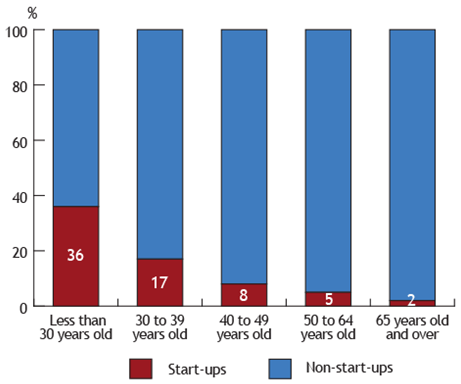
Sources: Statistics Canada, Survey on Financing and Growth of Small and Medium Enterprises, 2014; and ISED's calculations.
3.1.2 Owners' Gender
In 2014, start-up owners were more likely to be men than women. Close to two out of three (63 percent) of the start-ups were majority male-owned, whereas only 20 percent were majority female-owned (Figure 2). Seventeen percent of start-ups were equally owned by men and women. The distribution of start-up owners by gender was in line with that of non-start-up owners.
Figure 2: Ownership by Gender
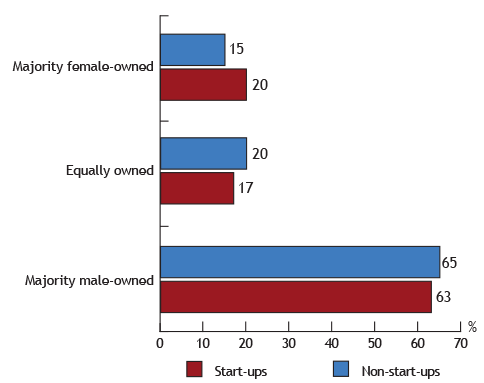
Sources: Statistics Canada, Survey on Financing and Growth of Small and Medium Enterprises, 2014; and ISED's calculations.
3.1.3 Education
About 79 percent of start-up owners had a post-secondary education: 32 percent received a college, CEGEP or trade school education; 32 percent a bachelor's degree and 15 percent a master's degree or above (Figure 3). The higher share of start-up owners (79 percent) had a post-secondary degree than non-start-up owners (69 percent), indicating that start-up owners were better educated than non-start-up owners.
Figure 3: Share of Start-Ups by Owners' Education
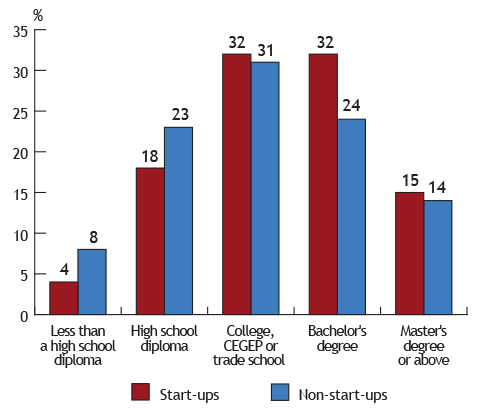
Sources: Statistics Canada, Survey on Financing and Growth of Small and Medium Enterprises, 2014; and ISED's calculations.
3.1.4 Management Experience
Start-up owners had less management or ownership experience than those owning older firms. Of owners with more than 10 years of management or ownership experience, 41 percent were start-up owners compared with 78 percent non-start-up owners (Table 2). Only 4 percent of non-start-up owners had less than 5 years of experience compared with 33 percent of start-up owners.
| Start-ups (%) | Non-start-ups (%) | |
|---|---|---|
| Less than 5 years | 33 | 4 |
| 5 to 10 years | 26 | 18 |
| More than 10 years | 41 | 78 |
| Sources: Statistics Canada, Survey on Financing and Growth of Small and Medium Enterprises, 2014; and ISED's calculations. | ||
3.1.5 Immigrant/Aboriginal/Visible Minority
Start-up owners had diverse backgrounds: 33 percent were born outside of Canada (immigrants), 1 percent were Aboriginal and 15 percent were visible minorities in 2014 (Table 3).
Both immigrant and visible-minority owners were more likely to start firms than non-immigrant and non-visible-minority owners. Among businesses owned by immigrants and visible minorities, 11 percent and 12 percent, respectively, were start-ups compared with 7 percent of start-ups owned by both non-immigrants and non-visible minorities. In contrast, businesses owned by Aboriginals were less likely to be start-ups than businesses owned by non-Aboriginals (5 percent of businesses owned by Aboriginals were start-up firms compared with 8 percent of businesses owned by non-Aboriginals).
| Distribution of start-ups (%) | Percentage of start-ups by owners' background (%) | |
|---|---|---|
| Immigrant | 33 | 11 |
| Non-immigrant | 67 | 7 |
| Aboriginal | 1 | 5 |
| Non-Aboriginal | 99 | 8 |
| Visible minority | 15 | 12 |
| Non-visible minority | 85 | 7 |
| Sources: Statistics Canada, Survey on Financing and Growth of Small and Medium Enterprises, 2014; and ISED's calculations. | ||
3.2 Business Characteristics
3.2.1 Exports
Start-ups were less likely to export than older firms, and export propensityFootnote 2 was positively related to the firms' age group. In 2014, 8 percent of start-ups exported compared with 11 percent of firms in operation for 3 to 10 years and 13 percent of firms in operation for 11 years and over (Figure 4). Thus, established firms were more likely to export.
Figure 4: Export Propensity by Age of Business

Sources: Statistics Canada, Survey on Financing and Growth of Small and Medium Enterprises, 2014; and ISED's calculations.
Start-up exporters relied more on the U.S. market than non-start-up exporters, while less on the rest of the global market. Of start-up exporters, 93 percent went to the United States compared with 89 percent of non-start-up (Figure 5). In contrast, start-up exporters sold less to the rest of the global market: 20 percent of start-ups had sales to Europe compared with 32 percent of these by non-start-ups; 9 percent to the Asian market, other than China, compared with 16 percent; 7 percent to Latin America compared with 17 percent and 5 percent to China compared with 14 percent.
Figure 5: Export Propensity by Destination of Sales
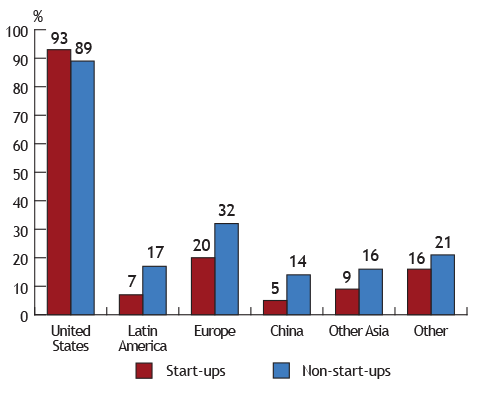
Sources: Statistics Canada, Survey on Financing and Growth of Small and Medium Enterprises, 2014; and ISED's calculations.
In 2014, younger firms were more likely to expand sales into new markets within Canada than older firms, suggested by the downward slope of intended new markets by age group (Figure 6). Among start-ups, 48 percent intended to expand sales within the local municipality or region; 35 percent outside the local municipality or region, but within the same province/territory; and 20 percent within the rest of Canada. These intentions were higher than those of firms in older age groups, possibly indicating that younger firms were more growth oriented toward markets within Canada. Intentions to expand sales into foreign markets (export), however, were similar between start-ups and non-start-ups. Ten percent of start-ups intended to export compared with 11 percent of firms in operation for 3 to 10 years, 13 percent of firms in operation for 11 to 20 years and 11 percent of firms in operation for more than 20 years.
Figure 6: Intention to Expand Sales into New Markets
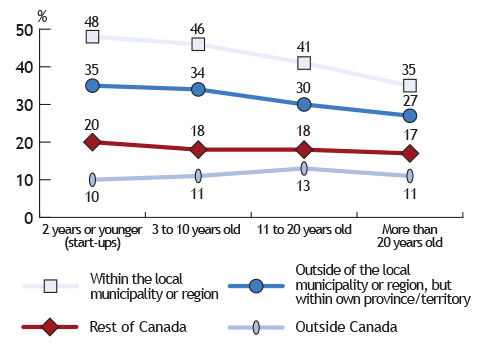
Sources: Statistics Canada, Survey on Financing and Growth of Small and Medium Enterprises, 2014; and ISED's calculations.
3.2.2 Innovation
Firms appeared to be more innovative when they were young and in the growth stage. In 2014, 43 percent of start-ups and 44 percent of firms 3 to 10 years old introduced at least one type of innovation (product, process, organizational or market innovation) compared with 40 percent of firms 11 to 20 years old and 41 percent of firms more than 20 years old (Figure 7).
Figure 7: Innovation Activity by Business Age

Sources: Statistics Canada, Survey on Financing and Growth of Small and Medium Enterprises, 2014; and ISED's calculations.
Start-ups were less likely to own intellectual property than non-start-ups. About 19 percent of start-ups owned some type of intellectual property compared with 22 percent of non-start-ups.
3.2.3 Sales Growth
Sales growth expectations were higher among start-ups than non-start-ups, and younger firms were more growth oriented than older firms. In 2014, 35 percent of start-ups expected to achieve sales growth over 10 percent per year compared with 30 percent of firms 3 to 10 years old, 16 percent of firms 11 to 20 years old and 15 percent of firms more than 20 years old (Figure 8).
Figure 8: Expected Average Annual Sales Growth (above 10 percent) over the Next Three years

Sources: Statistics Canada, Survey on Financing and Growth of Small and Medium Enterprises, 2014; and ISED's calculations.
3.3 Access to Financing
3.3.1 Financing Needs
Access to financing can be an important condition for business growth, and even more so for the survival of start-up businesses, especially if they have yet to establish a stable flow of income.
Overall, start-ups had higher demands for external financing than non-start-ups, with 58 percent of start-ups requesting some form of external financing compared with 51 percent of non-start-ups (Table 4). When asked why firms did not request financing, 81 percent of start-ups reported that financing was not required compared with 89 percent of non-start-ups. The two main reasons expressed by start-ups for not requesting financing when needed were concerns that the request would be turned down (5 percent) and that applying for financing was too difficult or time consuming (5 percent).
Request rates for debt financing were also higher among start-ups than non-start-ups. In addition, requests for debt financing decreased among older firms. In 2014, 37 percent of start-ups requested debt financing compared with 31 percent of firms in operation for 3 to 10 years, 27 percent of firms in operation for 11 to 20 years and 25 percent of firms in operation for more than 20 years (Figure 9). In contrast, the debt financing approval rates were lower among start-ups than non-start-ups. In addition, the approval rate increased among older firms. In 2014, 75 percent of debt financing requests was approved for start-ups compared with 78 percent for firms in operation for 3 to 10 years, 84 percent for firms in operation for 11 to 20 years and 88 percent for firms in operation for more than 20 years. This suggests that, although in greater need of financing, start-ups had more difficulty obtaining financing than older firms. This might be due to poor credit experience or a lack of credit history on the part of the start-up.
| Requested external financing (%) | Financing not required (%) | Concern that request would be turned down (%) | Applying for financing too difficult or time consuming (%) | Cost of financing too high (%) | Unaware of financing sources available to business (%) | Other (%) | |
|---|---|---|---|---|---|---|---|
| Start-ups | 58 | 81 | 5 | 5 | 2 | 4 | 5 |
| Non-start-ups | 51 | 89 | 2 | 2 | 1 | 3 | 4 |
| Sources: Statistics Canada, Survey on Financing and Growth of Small and Medium Enterprises, 2014; and ISED's calculations. | |||||||
Figure 9: Debt Financing Request Rate and Approval Rate

Sources: Statistics Canada, Survey on Financing and Growth of Small and Medium Enterprises, 2014; and ISED's calculations.
Among requested forms of debt financing, start-ups were more likely to request credit cards and lines of credit. In 2014, 22 percent of start-ups requested credit cards, 19 percent lines of credit, 8 percent term loans and 3 percent non-residential mortgages.
Both start-ups and non-start-ups were provided with debt financing at relatively similar interest rates, lengths of loans and requests to pledge collateral to secure financing. In 2014, the average interest rate paid by start-ups for non-residential mortgages was 5.3 percent compared with 4.7 percent by non-start-ups; 5.4 percent for lines of credit by start-ups compared with 5.2 percent by non-start-ups; 5.9 percent for term loans by start-ups compared with 5.2 percent by non-start-ups and 18.1 percent for credit cards by start-ups compared with 17.2 percent by non-start-ups (Figure 10). The average length of non-residential mortgages was 106 months for start-ups compared with 119 months for non-start-ups and the average length of term loans was 62 months for start-ups compared with 60 months for non-start-ups. Sixty-four percent of start-ups were required to provide collateral to obtain financing compared with 67 percent of non-start-ups.
Figure 10: Debt Financing Interest Rates, Lengths of Loans and Requirements to Provide Collateral

Sources: Statistics Canada, Survey on Financing and Growth of Small and Medium Enterprises, 2014; and ISED's calculations.
In 2014, start-ups were more inclined than non-start-ups to use loans for working capital/operating capital, with 74 percent of start-ups planning to use the financing for working capital/operating capital compared with 61 percent of non-start-ups (Figure 11).
Figure 11: Intended Use of Debt Financing
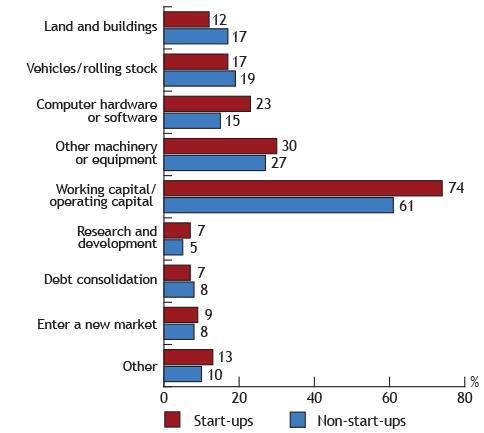
Sources: Statistics Canada, Survey on Financing and Growth of Small and Medium Enterprises, 2014; and ISED's calculations.
4. Key Findings and Conclusions
The vast majority of start-up owners were between 30 and 64 years old. Not surprisingly, the likelihood of establishing a new firm decreased as owners aged. Start-up owners were more likely to be men than women, as in the general SME population. The distribution of start-up owners by gender was in line with that of non-start-up owners. More than three quarters of start-up owners had a post-secondary education: 32 percent received a college, CEGEP or trade school education; 32 percent a bachelor's degree and 15 percent a master's degree or above. This suggested that start-up owners were better educated than non-start-up owners. Start-up owners had less management or ownership experience than those owning older firms. The background of start-up owners is diverse: 33 percent were born outside of Canada (immigrants), 1 percent were Aboriginal and 15 percent were visible minorities in 2014. Both immigrant and visible-minority owners were more likely to start firms than non-immigrant and non-visible-minority owners, whereas Aboriginal owners were less likely to own start-up businesses than non-Aboriginal owners.
Start-ups were less likely to export than older firms, and export propensity was positively related to the firms' age group. Start-up exporters relied more on the U.S. market than non-start-up exporters, while less on the rest of the global market. Firms appeared to be more innovative when they were young and in the growth stage.
Overall, start-ups had higher demands for external financing than non-start-ups, with 58 percent of start-ups requesting some form of external financing compared with 51 percent of non-start-ups. The two main reasons expressed by start-ups for not requesting financing when needed were concerns that the request would be turned down and that applying for financing was too difficult or time consuming. Debt financing request and approval rates suggest that, although in greater need of financing, start-ups had more difficulty obtaining financing than older firms. Both start-ups and non-start-ups were provided with debt financing at comparable interest rates. Similarly, the majority of start-ups and non-start-ups were also asked to pledge collateral to secure financing. Finally, start-ups were more inclined than non-start-ups to use loans for working capital/operating capital.
References
Acs, Z.J. and D.B. Audretsch (1989). "Births and firm size." Southern Economic Journal, 55, 467–475.
Acs, Z.J. and D.B. Audretsch (1990). "Innovation and Small Firms." Cambridge: MIT Press.
Acs, Z.J. and D.B. Audretsch (2003). "Innovation and Technological Change." Handbook of Entrepreneurship Research. An Interdisciplinary Survey and Introduction, 55–79. Edited by Acs, Z.J. and D.B. Audretsch. Dordrecht: Kluwer Academic Publishers.
Archambault, R. and M. Song (2018). "Canadian New Firms: Birth and Survival Rates over the Period 2002–2014." Ottawa: Innovation, Science and Economic Development Canada.
Audretsch, D.B. and M. Feldman (1996). "R&D spillovers and the geography of innovation and production." American Economic Review, 86(3), 630–640.
Audretsch, D.B. and M.C. Keilbach (2004). "Entrepreneurship and regional growth: An evolutionary interpretation." Journal of Evolutionary Economics, 14(5), 605–616.
Audretsch, D.B., M.C. Keilbach and E.E. Lehmann (2006). "Entrepreneurship and Economic Growth." New York: Oxford University Press.
Baldwin, J.R. and J. Johnson (1999). "Entry, Innovation and Firm Growth." Are Small Firms Important? Their Role and Impact, 51–77. Edited by Acs, Z.J. Dordrecht: Kluwer Academic Publishers.
Baldwin, J.R., W. Chandler, C. Le and T. Papailiadis (1994). "Strategies for Success: A Profile of Growing Small and Medium-Sized Enterprises in Canada." Statistics Canada, Cat. No. 61–523.
Budget 2016. "Growing the Middle Class." Available at Department of Finance Canada.
Cao, S., M. Salameh, M. Seki and P. St-Amant (2015). "Trends in Firm Entry and New Entrepreneurship in Canada." Bank of Canada Discussion Paper, 2015–11.
Hart, P.E. and N. Oulton (2001). "Galtonian regression, company age and job generation 1986–95." Scottish Journal of Political Economy, 48, 82–98.
Leung, D. (2015). "Quarterly Business and Employment Dynamics: Experimental Estimates, First Quarter 2001 to Third Quarter 2014." Statistics Canada, Economic Insights.
Macdonald, R. (2014). "Business Entry and Exit Rates in Canada: A 30-Year Perspective." Statistics Canada, Economic Insights, No. 038.
Organisation for Economic Co-operation and Development (OECD) (2003). "The Sources of Economic Growth in OECD Countries." Paris: OECD.
Statistics Canada, Survey on Financing and Growth of Small and Medium Enterprises, 2014.
Thurik, A.R. (2003). "Entrepreneurship and unemployment in the UK." Scottish Journal of Political Economy, 50(3), 264–290.
Van Stel, A.J., M. Carree and A.R. Thurik (2005). "The effect of entrepreneurial activity on national economic growth." Small Business Economics, 24, 311–321.
Varga, A. and J. Schalk (2004). "Knowledge spillovers, agglomeration and macroeconomic growth: An empirical approach." Regional Studies, 38(8), 977–989.

